Father and son Tom and Donal Kennedy berthed their new family-owned vessel Fiona K III T 117 at Dingle for the first time towards the end of last month, reports David Linkie
Being designed to fish a combination of seasonal pelagic and demersal species, including herring, mackerel, scad, tuna and whitefish, the multi-purpose vessel features interesting working arrangements. Pelagic fish are pumped aboard at the stern, while tuna and whitefish will be lifted onboard at the starboard shoulder.
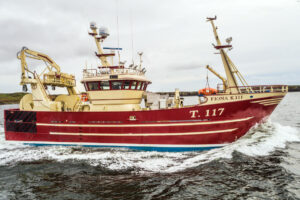
Fiona K III heads out of Killybegs for sea trials. (Photo: Alan Hennigan)
Named after skipper Tom Kennedy’s daughter and operating with a crew of six, Fiona K III is now midwater pair-trawling to the west of Ireland for scad with skipper Neil Minihane’s Ocean Venture II S121. Wheelhouse duties on Fiona K III will be shared between Tom Kennedy, his son Donal Kennedy and mate Diarmuid O’Neil.
Of 27.46m LOA, Fiona K III also has the distinction of being the biggest fishing vessel to be delivered by Mooney Boats Ltd to date. With a number of other local companies, including SeaQuest Systems, EK Marine, KER Group, Tom Hand Electronics (Dingle), Barry Electronics and Padmos (Kilmore Quay), supplying customised equipment and machinery packages to Fiona K III, the vessel is very much an Irish boat built in Ireland, of which all involved can be justifiably proud.
Killybegs netmaker Swan Net-Gundry supplied the new midwater gear now being used by Fiona K III.
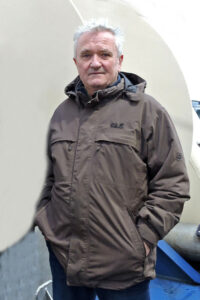
Fiona K III skipper Tom Kennedy.
Skipper Tom Kennedy said: “We are delighted with the end result. The design and build of the new boat was a big project for everyone involved. From the initial discussions, the encouragement and support we received has been simply fantastic, and is only matched by the high level of machinery installation and fit-out that is self-evident throughout Fiona K III.
“Designing and equipping a truly multi-purpose boat requires a high degree of forward planning, and a willingness to manufacture customised equipment, in order to ensure full integration at the end of the day. That Fiona K III performed exceptionally well on sea trials, and since we started fishing, is testament to the skills of everyone who contributed to the end result, for which we are very thankful.”
Built to replace the 18-year-old and 26.5m Fiona K II, the new boat is based on a round bilge hull form designed by Ove Kristensen of Vestværftet ApS, Hvide Sande, Denmark.
Naval architect Noel O’Regan of Promara also liaised closely with skipper Tom Kennedy throughout the project, during which he was very helpful.
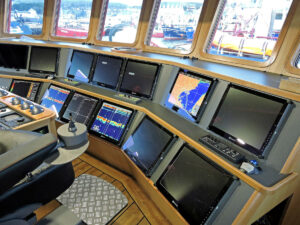
The main forward console in the well-finished wheelhouse…
Fiona K III is the fourth vessel to result from the successful and ongoing association between the Killybegs and Hvide Sande boatyards.
The productive relationship began some five years ago, when Mooney Boats fitted out the Vestværftet-designed 23.99m prawn freezer trawler Patrick C DA 107 for the Supreme Fishing Company of Clogherhead, which also took delivery of the similar Stella Nova DA 57 just 10 months ago. Between these two new-builds, Mooney Boats completed the 25.6m multi-rig prawn freezer trawler Audacious for Clogherhead brothers David and Niall Kirwan.
Mooney Boats is now preparing to carry out full machinery installation and fit-out of the 28.5m whitefish twin-rig stern trawler Ocean Challenge LK 253 for the Ocean Way Fishing Company of Skerries, Shetland. Also designed by Ove Kristensen of Vestværftet ApS, this boat is scheduled for delivery in the spring of next year.

… in which a distinctive Fiona K III compass rose is inlaid in the modern flooring.
Fiona K III’s hull was built to Bureau Veritas classification at the Nauta shipyard in Poland, before being towed across the North Sea to Killybegs in May 2018 for machinery installation and full internal fit-out by Mooney Boats, where work continued to be overseen by Bureau Veritas and the Irish Marine Survey Office for vessels over 24m.
From the outset, a key requirement by the owners was for the new boat to feature the latest design, fishing and propulsion technologies, in order to operate with enhanced levels of efficiency and safety.
General layout
Featuring a full-length shelterdeck and round bilge hull, Fiona K III has an overall length of 27.46m, a registered length of 24.46m, 7.8m of beam, and a moulded depth to shelterdeck of 6.1m.
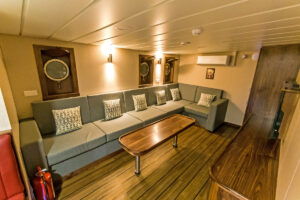
The day lounge is arranged in the forward starboard corner of the full-width deck house on the main deck…
Extensive liaison between the owners and builders has resulted in maximal use being made of the internal space available on Fiona K III.
The hull below the main deck is subdivided from forward into seven watertight compartments: forepeak/thruster compartment, sonar room, RSW machinery room, dry hold, RSW tanks, engineroom, and steering gear flat, including fuel, lube and hydraulic oil tanks.
The vessel’s main accommodation areas are arranged in the deck house, which extends across the full beam from the transom to amidships at main deck level.
Three twin-berth cabins are arranged across the stern. A single-berth skipper’s cabin is positioned on the centreline in the forward section of the deck house. A large shower/WC room lies to port in the same area on the main deck, where a crew changing-room lines the starboard side, forward of a general stores workshop. The messdeck is situated on the portside of the central galley, and aft of the day lounge.
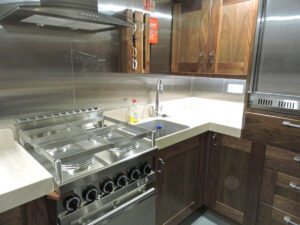
… forward of the adjacent messdeck.
The open-plan messdeck and day lounge, which includes a large corner seating area upholstered in red leather, were finished to a very high standard by Mooney Boats’ joiners, with solid walnut fronts and Corian worktops.
A passageway on the starboard side of the centreline provides direct crew access from the accommodation area aft, forward to the whitefish deck.
A ship’s rescue boat, served by a dedicated Palfinger launch/retrieve davit-arm crane mounted to port on the whaleback, is carried in compliance with Irish Marine Survey Office requirements for vessels over 24m.
Trawling arrangements
Trawling arrangements on Fiona K III generally follow a well-proven layout.
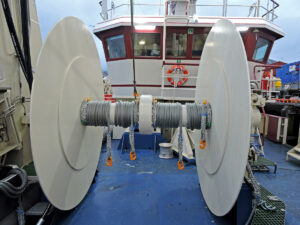
Two sets of trawls can be worked off each of the 2 x 12.5t split net drums.
The bespoke deck machinery was designed and manufactured by SeaQuest Systems. This continued a well-established relationship, as MD Bert Leslie also supplied a full package of deck equipment for installation on skipper Tom Kennedy’s previous new boat, Fiona K II, 18 years ago.
The Killybegs specialist also installed an autotrawl system on Fiona K III, custom-designed to meet Tom Kennedy’s requirements.
Two split trawl winches are fitted forward on the shelterdeck under an extended whaleback, the fore section of which is fully enclosed to provide secure storage for spare gear.
Rated 20t core pull, the split trawl winches feature grooved barrels to ensure accurate wire spooling at all times. When pair-trawling, the headline and footrope wires are worked off the port and starboard winches respectively.
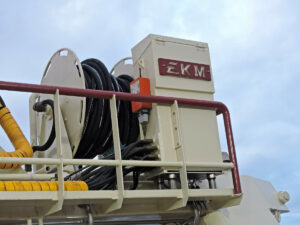
The hydraulic pipes for the fish hose are worked from a reel on the trawl gantry…
From the split winches, the trawl wires lead directly aft to towing blocks slung from fabricated trawl gallows incorporated into the stylishly raked main stern gantry.
Two split net drums (2 x 12.5t) are mounted either side of the centreline aft on the shelterdeck, in line with large-diameter rollers atop the transom rail. This arrangement enables Fiona K III to carry four nets ready to shoot.
Topline and tail-end winches (20t), spooled with Dyneema warp, are mounted on the shelterdeck abaft the wheelhouse.
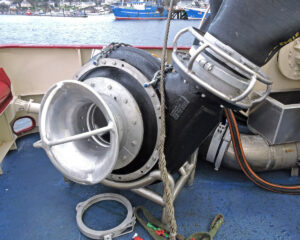
… directly above the SeaQuest 14in fish pump, positioned at the port quarter of the shelterdeck.
Gear-handling on the quarter, where there is considerable space for laying out torn nets for mending, is further assisted by a powerblock crane custom-built by EK Marine. Positioned centrally on the trawl gantry, the crane is flanked on the starboard side by a net sounder winch (which also features a grooved drum), and to port by the reel serving the hydraulic pipes.
The dual-purpose net-handling and fish-pumping knuckle-boom crane has a lifting capacity of 1.5t @ 7.0m. The radio remote-control crane features a two-speed 2t Rotzler winch with a capacity for 61m of 10mm-diameter wire, and a rotating and tilting head for 24in powerblock and sheave block for the winch wire.
Fish-handling
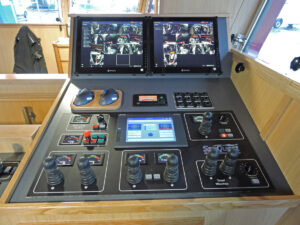
Every item of SeaQuest deck machinery on Fiona K III can be operated from the fishing console, which includes a SeaQuest autotrawl system.
A 14in SeaQuest fish pump, positioned on the portside of the shelterdeck, is used to pump catches of herring, mackerel and scad aboard over the stern of Fiona K III. A section of the transom bulwark is recessed and fitted with a roller along the bottom edge, to ensure that the fish hose is safely secured at all times during pumping operations.
The SeaQuest pump-through fish hose reel is mounted on the shelterdeck directly forward of the pump itself. The hydraulic hoses for this are spooled onto a reel with a capacity for 2 x 60m of 1.5in-diameter hydraulic hoses, mounted directly overhead on the trawl gantry.
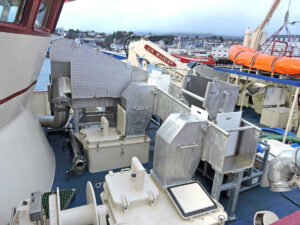
The fish dewatering unit was designed and fabricated by Mooney Boats.
When pumping begins, fish are transported forward on the port side of the vessel through a 14in stainless steel pipe to the separator unit amidships. The delivery pipe incorporates a short section of Perspex, positioned so that it can be viewed from the trawl console in the wheelhouse, as well as by the crew working on deck, from where the flow of fish and water from the pump can be controlled to deliver premium catch quality.
Custom-designed and manufactured by Mooney Boats, the separator guides pelagic fish to one of the vessel’s three RSW tanks, which are arranged across the full beam, slightly aft of amidships.
KER Group of Killybegs supplied and installed the refrigeration systems deployed to keep Fiona K III’s catches in optimum condition. The vessel’s RSW system is driven by electrically powered Azcue pumps, including 15kW/220m³/hr RSW and 5.5kW/85m³/hr condenser cooling units.
A conventional stainless steel piped chilling system is fitted in the dry hold, which is also served by a Geneglace 2.5t flake ice machine.
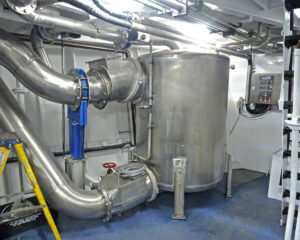
The vacuum discharge tank…
On returning to harbour from the fishing grounds, pelagic fish are discharged using a SeaQuest vacuum pump system. Located on the port side of the main deck forward, the radio remote-controlled system includes a 2,000-litre stainless steel tank and two electrically driven Samson V21 compressors with bronze end plates. The stainless steel knife-gate valves for the three RSW tanks and blowback system are all piped below the shelterdeck and operated with pneumatic valves.
Catch-landing is assisted by a telescopic folding knuckle-boom crane mounted on the port side of the shelterdeck. Manufactured by EK Marine to a full marine specification, the crane is the first of its type to be designed and built in Ireland. The slew base incorporates a stainless steel slew ring, providing more power and control and a better level of operation than the slew cylinders traditionally found on cranes of this capacity.
The column and boom are constructed from laser-cut Hardox steel, which enables thinner, lighter sections to be used, as it is over twice the strength of conventional high-strength steel, decreasing the weight of the crane and increasing the stability of the vessel. The boom has two extensions and is capable of lifting 1.5t @ 10m. It is equipped with a two-speed 2t Rotzler winch.
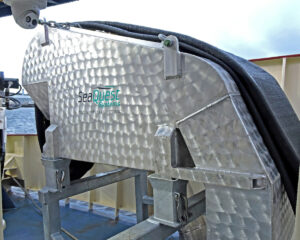
… and landing delivery chute, supplied by SeaQuest Systems.
As is customary, after being fabricated by EK Marine, both crane units were shotblasted to Grade SA 2.5-3.0/ISO standard and zinc-metalised to a thickness of 80µ. An International Marine epoxy paint system was then applied, including a primer coat of 20µ thickness, a 80µ first coat and a 50µ top coat.
Catches are taken in at two locations on Fiona K III, depending on which fishery is being targeted by the vessel owners. Outside the seasonal early and late-year pelagic fisheries, Fiona K III is expected to engage in tuna and whitefish activity.
When operating in these modes, catches will be taken aboard in the conventional manner forward, using a removable A-frame lifting gantry and a dedicated Gilson winch (10t). This process will be further assisted by using a second mid-line splitter winch (20t), mounted on the shelterdeck at the forward starboard corner of the wheelhouse.
On being released from a large reception hopper, demersal catches are moved across the vessel by a conveyer, from which they are selected and gutted. Fish are cleaned in a washer, manufactured by the boatyard and positioned forward of the conveyer, and then lowered into the dry hold forward of amidships.
Mooney Boats also designed and fabricated the bespoke handling system used to take tuna from the hopper aft for distribution to the RSW tank tops on the main deck.
Engineroom
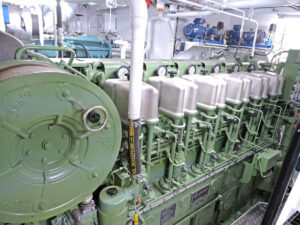
Fiona K III’s ABC 6DZC main engine.
Padmos of Kilmore Quay supplied Fiona K III’s engine package, full installation of which was carried out by Mooney Boats engineers. The engines were lifted aboard before the hull left Poland to be towed to Co Donegal.
The ABC 6DZC Mitsubishi S6U main engine is coupled to a Hundested CPGD 120 7.04:1 reduction gearbox, to turn a Hundested variable-pitch four-bladed propeller of 2,800mm diameter, housed in a matching high-efficiency nozzle. This centreline package gave Fiona K III an average top speed of 10 knots on sea trials from Killybegs.
Load-sensing pumps for the main hydraulic systems are driven off three gearbox-mounted PTOs. Electrically driven towing and standby pumps are also fitted.
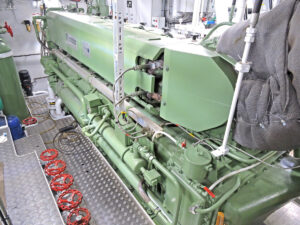
Engineroom machinery includes an ABC propulsion unit…
Two Newage Stamford 415/3/50 generators (295kVA and 120kVA) are driven by Mitsubishi S6B3-T2MPTAW and 6D16-T auxiliary engines. All three engines are box-cooled.
An air-cooled Mitsubishi S4SDT4S4B harbour genset (40kVA) is housed in a separate room forward under the main deck.
A Hundested SFT4 hydraulically driven bow thruster (120kW), together with Scan MT-2500 steering and four-station Seamech control stations, are also fitted.
Housed in a combination of four main deep tanks (two forward and two aft), together with a double bottom tank amidships and a day tank in the aft peak, Fiona K III starts a trip carrying 35,000 litres of fuel. Two wing tanks in the engineroom hold 15,000 litres of domestic freshwater.
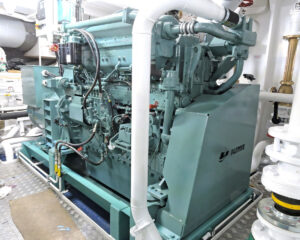
… and Mitsubishi auxiliaries driving Stamford generators.
Wheelhouse
Raised half a level from the shelterdeck, Fiona K III’s modern and well-laid-out aluminium wheelhouse provides skipper Tom Kennedy with excellent 360° vision. The ’tween deck space is used to full advantage to house the computers and control units for the vessel’s electronic equipment, together with electrical distribution cabinets, batteries and air conditioning units that serve all the accommodation areas in the deck house.
The extensive array of electronic equipment, displayed on flush-mounted AG Neovo monitors in the superbly finished wheelhouse, was supplied and commissioned by Tom Hand Electronics of Dingle and Barry Electronics of Killybegs.
Most of the electronics are flush-mounted in the main double-tier forward console, with the balance grouped together at the central trawl station aft. From the fishing console, skipper Tom Kennedy has full remote control of all deck machinery, including the split trawl winches, which are operated through a SeaQuest autotrawl system.

Flush-mounted screens in the main wheelhouse console display information from units supplied by Tom Hand and Barry Electronics.
Two NorSap 1500 skipper’s chairs, with the Kennedy family crest embroidered into the headrests and the black leather stitched in red to match the hull colour, flank the centre console, on which one of the four sets of Seamech bridge controls is fitted. A further three units are available at the port and starboard wing consoles and aft at the trawl console.
When searching for marks on the grounds, the first signs of fish are detected by Kaijo-Denki KCS-5211 low-frequency and Kaijo-Denki KCS-5885 medium-frequency omni-sounders. The high level of performance delivered by these sonars was immediately apparent on sea trials in Donegal Bay, when Fiona K III marked some good spots of herring tight to the bottom at 700m.
For vertical sounding, Fiona K III is equipped with two Koden CVS-FX2BB broadband multi-frequency echosounders, and a Simrad ES-80 38/200kHz sounder featuring split-beam 38kHz and 200kHz transducers. The latter can operate in CHIRP mode, sweeping through a range of frequencies for optimal echo-detection of fish close to the seabed.
The Wesmar TCS-385 net sonar gives separate net profile and down sounder outputs.

The centre console.
The Marport net-sensor system receives net data through three hydrophones simultaneously, giving excellent reception of all sensor data from the net and doors, including pitch and roll. The catch sensors can transmit to both the trawl sonar and hull hydrophones, ensuring that catch sensor data is always available to the skipper. A Marport tunnel sensor gives a proper echosounder-type display of the net tunnel. All information received from the gear sensors is displayed on Marport’s Scala software, powered by Apple to provide a very flexible and fast system.
Navigation equipment includes Furuno FAR-1518 and Furuno FAR-1318 X-band radars, 2 x Sodena TurboWin plotting systems c/w AIS/ARPA and tidal modules, 2 x Koden KGP-920 GPS receivers, JRC JLR-21 GPS gyro compass, Simrad AP70 and AP60 autopilots, and Furuno FA-170 AIS.
Fiona K III’s comprehensive communications package consists of a Sailor 6310 MF/HF DSC radio telephone, Sailor 6222 DSC and Icom VHFs, 3 x Icom IC-GM 1600E portable GMDSS VHFs, JRC NCR-333 Navtex receiver, Phontech 10 station intercom, Standard Horizon intercom/loud-hailer, 2 x McMurdo SARTs, McMurdo G8 Smartfind EPIRB, BEL Vsat system, Intellian t80Q satellite TV, and BEL CCTV system.
The extensive CCTV system includes 15 high-resolution cameras. Installed by BEL, the system is viewable at three different locations aboard Fiona K III. In addition, the camera system is fully integrated into the boat’s network, allowing easy security-monitoring of the vessel’s CCTV when Fiona K III is in harbour for extended periods.
Mooney Boats building for NE Scotland and Shetland
Mooney Boats is currently fabricating the hull of a 20.22m twin-rig trawler for a Gardenstown partnership in its boatbuilding hall at Killybegs. Designed by SC McAllister & Co Ltd, the fully shelterdecked vessel has a registered length of 18.75m and 7.3m beam.
The new build will feature a Mitsubishi S6R2 MPTK main engine and a Reintjes WAF374 7.09:1 gearbox. Mitsubishi 6D24-TC and 6D16-T auxiliary engines will run 120kVA and 70kVA electrical generators, together with the trawler’s main hydraulic pumps.
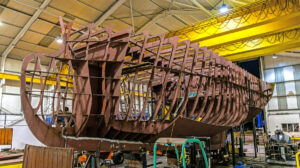
Work in progress on the 20.22m twin-rig trawler that Mooney Boats is building for a Fraserburgh-based partnership.
Fuel and freshwater capacities will be 16,000 and 13,000 litres respectively.
EK Marine will supply the deck machinery package, including a two-speed three-drum trawl winch, two 2 x 12.5t net drums, and an 8t Gilson.
Mooney Boats is also preparing to begin full machinery installation and internal fit-out of a 28.5m twin-rig whitefish trawler, for delivery in 2020 to Shetland skipper Leslie Hughson of the Skerries family-based Ocean Way Fishing Company. The hull of this boat is currently under construction in Poland.
To be named Ocean Challenge LK 253, the trawler is designed by Ove Kristensen of Vestværftet ApS. The main dimensions of the round bilge hull are registered length 23.9m, beam 8.7m, and a depth moulded to shelterdeck of 6.45m.
Ocean Challenge will be powered by an ABC main engine, a Heimdal gearbox and a 3,000mm-diameter CP propeller. Three Cummins auxiliary engines will also be fitted in the aft engineroom. The boat will carry 51,000 litres of fuel and 28,000 litres of freshwater.
The MacGregor Group of Peterhead is manufacturing a full package of deck machinery for Ocean Challenge. Three 18t split trawl winches will be positioned amidships at shelterdeck level, forward of two 2 x 16t split net drums and two elevated 8t bagging drums.
Catches will be lifted aboard centrally at the stern by a 10t Gilson, before being released into a central reception hopper. After gutting, fish will be placed into rotating selection and washing drums before being delivered to the forward fishroom.
Ten berths will be provided in a combination of single and twin-berth cabins, mainly arranged on the main deck.
Fiona K III
Fiona K III replaces her similarly named predecessor Fiona K II T 117.
Fiona K II was built at the Tecnogomes shipyard, Lisbon, in 2000, to plans drawn up by Macduff Ship Design Ltd. Featuring a Caterpillar 3508 main engine, twin Mitsubishi auxiliary engines and SeaQuest deck machinery, the 23m Fiona K II was initially rigged for midwater trawling and gill-netting.
Fiona K II was lengthened at the Astilleros de Pasaia shipyard, Spain, in 2002, when a 3.5m section was inserted into the hull amidships, as part of an extensive refit.
When Fiona K III was nearing completion at Killybegs last year, her predecessor was bought by Aran Islands skipper Mairteen Conneely of Inis Mór, and renamed Realt Ara (Irish for ‘star of Aran’). Realt Ara replaces Mairteen Conneely’s previous boat, the 25m Iuda Naofa SO 679, which was lost north of the Butt of Lewis when returning to Killybegs from mackerel grounds west of Orkney in January 2015.
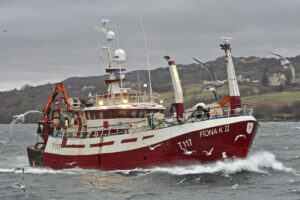
Fiona K II after being lengthened to 26.5m.
Skipper Tom Kennedy took delivery of Fiona K II in 2000, as a replacement for his previous boat, the original Fiona K. Named after Tom Kennedy’s daughter Fiona, this 19.4m steel-hulled vessel was fitted out at the Maritem shipyard, Cobh, in 1983 as Father Oliver G 192 for Aran Islands skipper John O’Donnell. Father Oliver’s hull was one of three built in Holland at this time for Aran Islands skippers, the other two being Westward Isle G 185 for Thomas Flaherty and Colmcille G 186 for Patrick Joyce.
Tom Kennedy sold Fiona K to Sweden in 1999, when the boat was rigged for prawn trawling and renamed Auster. After further name changes, including Gandor and Gano, the trawler continues to fish from Sweden, now as Canopus LL 377.








